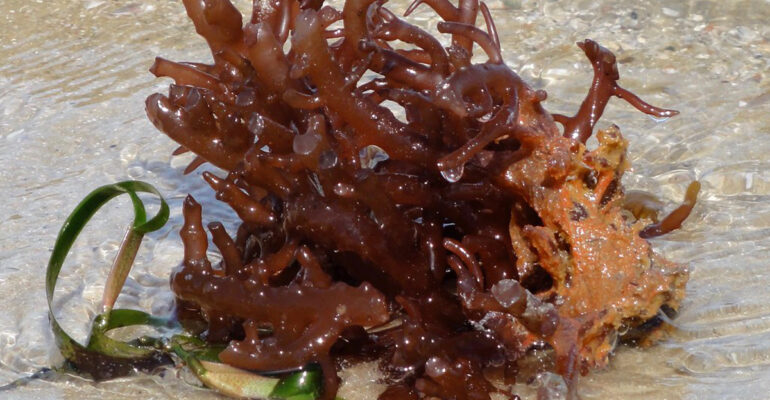IPB University Students Discover Methods for Taking Red Seaweed Pigments

Indonesia is the second highest seaweed producer in the world after China. Generally the seaweed industry conducts chemical extraction and produces liquid waste that has an impact on the environment. In addition, there are important seaweed pigments that are lost through chemical extraction. Therefore we need a method breakthrough in seaweed extraction.
Rida Aini Rahmawati, Aldi Rahman and Yashinta Yulianawati, students from the Department of Aquatic Product Technology, Faculty of Fisheries and Marine Sciences (FPIK) of IPB University conducted research related to seaweed extraction using enzymatic principles. Seaweed Kappaphycus alvarezii is generally extracted into carrageenan type kappa-carrageenan which is widely used as an emulsion in various food products (ice-cream, pudding), personal care (toothpaste, face cream, soap), pharmacutics (drug capsules) and bioplastics (substitute Plastic).
K. alvarezii Rhodophyta group has a dominant red pigment (Fikoeritrin). "Generally in the world of industry this red pigment is damaged by chemical processes, even though the benefits are very much for pharmaceuticals (antioxidants, anticancer, anti-inflammatory) and research (fluorescent, biomarkers)," said Rida. To maintain the pigment, the help of Marine endophytic fungi is needed in the extraction process.
The team that managed to get funding from Kemenristekdikti through the Student Creativity Program for Research (PKM-PE) in 2019 was guided by Dr. Custody of Tarman. They use marine endophytic molds that grow on stems or leaves.
The type used was mold RS6A isolated from coastal plants of ant nests. This mold produces cellulase enzymes which help the pigment extraction process. "The enzymatic method in seaweed extraction is used to improve hydrolysis efficiency, reduce costs and not produce residues. There has been no research on pigment extraction with endophytic mold cellulase marine enzymes, generally using terrestrial molds such as trichoderma sp / Aspergillus sp, "he said.
He added the uniqueness of this enzymatic extraction method is with the help of marine endophytic fungi that are capable of producing enzymes. With this method seaweed can not only be processed into carrageenan but also its pigment, the process is easy, efficient and environmentally friendly.
This study began by growing marine endophytic molds on solid media Potato Dextrose Agar (PDA) and Potato Dextrose Broth (GDP) followed by the production of enzymes on basal media. Furthermore, the process of enzymatic hydrolysis of seaweed for two hours. The results were obtained in the form of semi-pure extracts of cellulase enzymes, semi refined carrageenan (semi-pure carrageenan) and pigments of fikoeritrin pigments. (NR)



